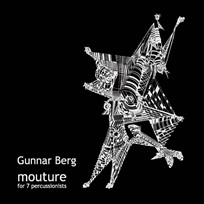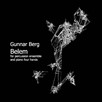
Mouture
Composer: Gunnar Berg
Instrument: Percussion Ensemble
Level: Intermediate
Published: 2008
Price: €35.00
Item details
-
Description +
-
Duration: 7 min.
Gunnar Berg (1909-1989), a pioneer of serialist music in Denmark, was one of the most internationally known figures in recent Danish music history, consistently writing free atonal music, colourful, complex and full of explosive crackling energy.
In 1948 Berg went to Paris to study with Arthur Honegger and Olivier Messiaen. His stay in Paris lasted nearly 10 years, and his encounter with the musical avant-garde in Paris was important. The recording of Edgar Varèse's "Ionisation" (1929-1931), which he first heard together with the Italian/Swiss composer Giuseppe Englert, took him completely by surprise, so much so that percussion came to play a prominent role in his scores. The piano concerto "Essai acoustique" (1954) uses 6 percussionists, "Belem" (1957) is scored for 14 percussionists and piano (4 hands) and "Random" (1968) can be performed by 1 to 9 percussionists.
The first result of Gunnar Berg's encounter with Varèse's music was the ballet "Mouture" for 7 percussionists, composed in Neuilly s/Seine in Paris in 1953 and based on the theories of rhythm and movement of Swiss composer and pianist Jacques Dalcroze (1865-1950).
Gunnar Berg called "Mouture" an "Essai choréographique" and described it as a visual canon. The dancers perform the rhythmic formulas as a visual echo of the music. The French title "mouture" relates to a coffee (or flour) grinding mill and refers as well to the progress of the music and the choreographic score, where the rhythmic grains and movements are ground and crystallized into different rhythmic motifs, with a growing intensity in the sound texture which totally disintegrates.
"Mouture" was premiered during the Holland Festival 1956, where the Dutch dancer and choreographer Jaap Flier presented 11 acclaimed performances in 10 different cities in Holland.
-
-
Instrumentation +
-
Percussion Ensemble:
Player 1: 5 Bamoos / Marimba*
Player 2: Suspended Cymbal, Tenor Drum & Bass Drum
Player 3: Suspended Cymbal & 2 Snare Drums
Player 4: Triangel, Metal Cane & Anvil
Player 5: Triangel, Suspended Cymbal & Gong Gong
Player 6: 2 Gong Gongs
Player 7: Gong Gong & Wood-Block
*) Optional
-
-
About the composer +
-
In 2009, the 100th anniversary of the birth of Gunnar Berg (1909-1989) sparked a rediscovery and reassessment of the Danish composer as one of the most important Danish representatives of musical modernism on the international scene. More than 50 performances and events were held in Denmark, Germany, Austria, Switzerland, Finland, Ukraine, USA, China, France, Northern Ireland and Scotland. Berg’s music was played, discussed and written about to an extent never experienced by Berg, himself, in his lifetime. His drawings were also exhibited and his music was released both in print and on CD.
Gunnar Berg was born in St. Gallen in Switzerland on 11 January 1909, the oldest of four siblings. From 1890 his Danish father Sigvard Berg worked on the railway construction in Switzerland, but he died of a heart attack in 1914, only 60 years old. Consequently Berg’s youth in Switzerland and in Denmark was difficult, marked as it was by illness and frequent moves, and without much contact with music.
In 1934 Berg graduated from a business school in Copenhagen, despite having been so deeply affected by a 1931 performance of Wagner’s Tannhäuser at the Royal Theatre that he vowed to devote his life to music. In the summer of 1932 Berg bicycled from Copenhagen to Salzburg, and during the music festival he attended a course given by Austrian music critic Paul Stefan at the Mozarteum. The course opened doors for Berg; he attended rehearsals, concerts and other courses as well as experienced decisive first encounters with the music of composers such as Debussy, Schönberg and Stravinsky. Berg returned to Salzburg in 1935, where he was granted access to rehearsals and concerts led by Arturo Toscanini and Bruno Walter, and where he attended the conductor course by Herbert von Karajan, with whom he had private meetings.
Berg’s time in Salzburg was of landmark importance to his musical orientation, for thereafter he was positioned closer to the music culture of Europe rather than to one that embodied a Danish-Nordic aesthetic. His stays in Salzburg certainly contrasted with his studies at the Royal Danish Academy of Music in Copenhagen in 1936 where his idea of establishing a study group for new music was met with blank refusal from the conservatory. He left at the end of the year, but continued to study piano with the pianist and composer Herman D. Koppel until 1943. From 1944 on Berg studied with Elizabeth Jürgens, an unusually gifted piano teacher of Swedish birth who had lived in Copenhagen for decades.
During the German occupation, Berg actively took part in the rescue of Danish Jews - transporting them to Sweden - and in the Danish resistance movement. After the liberation he was involved in music teaching projects at numerous refugee camps in Denmark and gave concerts featuring his own compositions, classics, and new music including works by Stravinsky, Satie and Honegger.
Berg’s first works date from the mid-1930s; Zehn japanische Holzschnitte (Ten Japanese Woodcuts) for voice and piano from 1938 is considered his first major work, and the three sonatas - for flute and clarinet (1942), for violin (1945) and for piano (1945-47) - with which Berg in the 1940s finally left classical formal structures behind, are significant contributions to this genre within the neoclassical style.
In January 1945 the autodidact composer debuted in Copenhagen, but Berg won no recognition for his music so he began to prepare to go abroad, and in autumn 1948 he went to Paris in order to study with Arthur Honegger at École normale. Berg quickly gained access to the circle around Olivier Messiaen and thus became part of the international modernist environment in post-war Europe. In 1950, at the invitation of Darius Milhaud, he attended the Salzburg Seminar in American Studies, and in 1952 he married the French pianist Béatrice Duffour. They spent their honeymoon at the International Summer Courses for New Music in Darmstadt, where Berg’s meeting with Karlheinz Stockhausen served to confirm the validity and contemporaneity of Berg’s own musical experiments. The couple made a number of concert tours around Europe featuring music of the leading composers of the time. In 1957 and 1958, funded by the French Ministry of Foreign Affairs, they toured Germany and Scandinavia, and then settled in Denmark. For a number of years thereafter the Berg couple embarked on a unique project with residences, lectures and concerts at the Danish Folk High Schools. In 1965 they established their first own home in the old school in Lindved, a very small village located between Horsens and Juelsminde in Jutland. There they created an unusual cultural venue where the people of the region were often invited to memorable concerts with contemporary and classical music. Béatrice Berg died 1976, and in 1979 Gunnar Berg returned to Europe and finally settled in Switzerland, where he experienced a significant surge of interest in his music. Gunnar Berg died in Bern, Switzerland, on 28 August 1989, and he and Béatrice Berg are both buried at the Rårup churchyard, close to their home in Lindved.
The 10-year stay in Paris proved crucial to Berg, and from 1950 he uncompromisingly, yet in his very own fashion, remained faithful to the complex expressive mode of musical modernism within the theoretical and aesthetic framework of serialism, and, it should be noted, without turning dogmatic.
Only very rarely did Gunnar Berg add analytical or explanatory comments to his music: “My works must stand on their own feet, and they must answer for themselves,” he asserted. However, among his posthumous papers there is a wealth of slips of paper with columns of figures and letters, note names, volumes and durations, which provide us some insight into his composition workshop. They also confirm the limited number of analyses of Gunnar Berg’s works that have attempted to map out his working method. Berg’s point of departure was Olivier Messiaen’s division of the twelve chromatic notes of the tempered scale into groups, the so-called “modes with restricted transpositions,” but expanded to apply to all the parameters of the music. The result is a meticulously calculated structuring of durations, pitches, volumes and instrumentation, which was a major theme in Darmstadt in 1952. Berg described his method as “static”, and he spoke of ground rules where, by means of techniques such as mirroring, reversal and transposition, he established a basic body of material to be ordered in his own, personal way.
Gunnar Berg came too late to his study of piano to attain a professional career as a pianist. However, his experiences at the piano decisively influenced his compositional thinking as reflected in his piano compositions – from the numerous small educational pieces to the four virtuoso concertos for piano and symphony orchestra: Essai acoustique (1954), Pour piano et orchestra (1959), Frise (1961) and Uculang (1967). The two major works for solo piano - Eclatements (1954-88) and Gaffky’s (1958-59) - both large compositions, are among the most important contributions to Danish piano literature in the second half of the twentieth century.
This is also the case with his contributions to Danish guitar literature after his meeting with Maria Kämmerling in 1976 which resulted in Fresque I-IV (1978), Hyperion (1978) for guitar, soprano and 9 instruments, Melos (1979) for solo guitar and Ar-Goat (1984) for guitar-duo.
-
-
Reviews +
-
Review (Percussive Notes, July (60) 2012)
Known for his writing of free atonal and serial music, this ensemble offering from Danish composer Gunnar Berg is a perfect example of global compositions influenced by classics such as John Cage’s “Constructions” and Varèse’s “Ionisation.”
Through the course of this ten-minute work, not only will percussionists be expected to navigate through pockets of subdivided triplets and quintuplets, they will also need to have a firm grasp of ensemble awareness as it pertains to fragmented melodies consisting of quarter and eighth notes. Additional challenges come in the form of producing characteristic sounds from idiophones where the composer calls for performance on multiple playing areas.
While no common rhythmic thread runs through the piece, there are clear moments of phrases and climax as Berg cleverly utilizes an entire dynamic range to establish, introduce, and demarcate various sections of music. Additionally, Berg leads the listener through a progression of rhythms, beginning with sparse and simple statements that morph into sections of dense activity. Successful performance of this work will require university performers that are sensitive, informed, and invested in music of this style so that it doesn’t simply sound like notes played from a page, and comes across as a legitimate musical work.
—Joshua D. Smith
-
-
Credits +
-
Foreword (Danish): Jens Rossel
Translation to English: Jan Williams
Front cover: Gunnar Berg
Front cover graphics and layout: Ronni Kot Wenzell
Printed in Copenhagen, Denmark
Copyright © Edition Svitzer
Duration: (7 min.)
www.editionsvitzer.com
-







